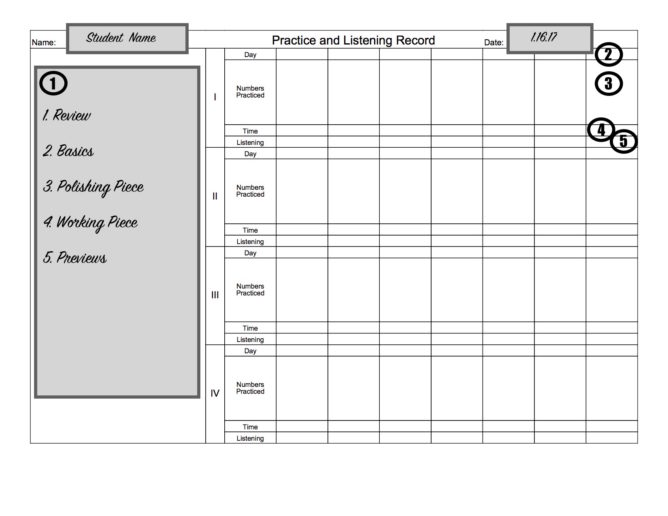
If you meet with your student for 30 minute lessons each week, you are seeing them for a mere 0.297% of their week. And if you hope that your work in the lesson will transfer into any tangible developments on the instrument, you better make sure your students know exactly what to practice at home.
Creating my own chart and getting consistent in my use of it revolutionized my studio. In my opinion, a simple, clear process for sending home practice assignments is essential.
Below you’ll find my practice chart (download your own, clean PDF here), instructions to use it, and some ideas for clarifying practice assignments.

I began using this chart two years ago. It is now completely integrated into my lesson routine and integral to the way families practice within my studio. Each student has a practice chart they carry in a notebook with their Suzuki book, parent journal for notes, and any supplemental reading materials.
Let me explain the components of the chart itself…
- The grey, boxed areas are the places I write and edit. The rest of the chart is for students and parents to complete in a four week cycle.
- Each student has their own, customized chart. In the top left corner I note the student’s name and in the top right I note the date the chart was begun on.
- (1) This is where I outline assignments for the week. Each assignment gets it own number.
- (2) On this row we notate the date or day of the week.
- (3) In this box students and parents write out the numbered assignment they practice. So, for example, if they only practiced review they would only note a #1. If they practiced everything they could write #1-5.
- (4) Student or parent jot down how long it took to practice that day.
- (5) If deliberate listening happened, I ask student or parent to put a check mark in the row labelled “Listening.”
My procedure for using the chart is as follows.
- When the old practice chart is completely filled out, I’ll pull a fresh one out at the end of a lesson and note the student’s name, date, and every practice point I want them to cover at home.
- Student and parent use the practice points to structure their home practice and record that practice throughout the week.
- Immediately upon walking into a lesson the student or parent hand me their practice chart and I take a look. I scan for the days practiced and the material practiced on that day. I ask myself questions such as, “Was it consistent? Were there any gaps? What can I expect in the lesson based on their home practice?” Sometimes I’ll actually address these questions to parent and student, too.
- We have our lesson. The practice chart sits on a stand for student, parent, and teacher to look at as necessary throughout the lesson.
- After we take our bow, I add or edit to the assignments on the cart from the last lesson. Many things we stay the same from week to week, so I only change what needs to be changed.
- We repeat this process each week until we need to make a new chart.
I’ve really come to love this system for several reasons.
- It isn’t too busy or overcomplicated. I only need one form of practice chart for all of my students, and after a week most students and parents understand how to use it. It is also customizable to the unique needs of the student. With pre-twinklers I’ll include, “1. Take a bow,” which, of course, isn’t necessary for students in Book 3 or 4. There is even room in the margin and on the back for extra notes or illustrations.
- The chart lasts for four weeks so I don’t waste time starting a new one from scratch every lesson.
- At a glance I can collect information on the practice and listening habits over the span of a month. Is there a particular day that is always a challenge? Are they avoiding practicing something in particular? Is listening happening? Is practicing taking 45 minutes when it should take 10? These are all patterns I can pick up in seconds by looking at the chart.
- For students and parents it is a tangible, written record of work and progress. The practice chart can be used as a tool to document what is (and what isn’t) happening. Often in noting what is happening — good or bad — habits can either shift or be reinforced.
Most importantly, practice charts offer a map to success. Students and parents can look at our 8.5X11 sheet of white paper and see exactly what I define as success for the week. I measure success not in the change made when they come back to me, but in showing up daily to do the work I numbered. Therefore, it is not the student’s or parent’s responsibility to improve week to week but my own responsibility to assign practice assignments that will shape progress.
Instead of sending students and parents on a trip in the dark without a road map or compass, I give them clear instructions that will lead them home. If it doesn’t, well that is my fault. And, luckily, I’m a far more experienced course corrector than they are.
Over time, I’ve gotten better at delivering explicit instructions that will lead to success. Here are a few rules of thumb…
- Numbers. If you can, include a number of successful repetitions (X10), amount of time (10 seconds), or metronome setting (60BPM).
- Focus Point. With review or new repertoire list out the “focus points” you want your students to direct their attention to while practicing. For example, I would list “4. Go Tell Aunt Rhody. Focus: Watch bow whole time.”
- References. If you want your student to consult a video, illustration, or record progress on a companion chart make sure to remind them next to assignment. For example, I would write “5. A Major Scale (see scale mastery chart)”
- Helpers. Instead of just listing what is going to happen, make sure it is clear who is going to do it. With younger students the work of the bow hold might still belong to the parent. And if a student is doing a new activity independently, note that. If a student, even an older one, needs the help of their practice parent, go ahead and add that to the assignment itself. For example, “4. Allegretto. Focus: bow on highway (parent watches and claps if student goes over fingerboard).”
- Sheet music. To refer to specific passages in a piece I use green tapes and label them alphabetically. For example, “4. Bach Double. Green Tape C, focus on dynamics, repeat 10 times correctly at quarter = 80 BPM.”
Even if you don’t adopt this entire practice chart system, I hope you found at least a few takeaways. Please be as explicit as you can when assigning home practice and take responsibility for your students’ progress, their journey to success depends on it.
